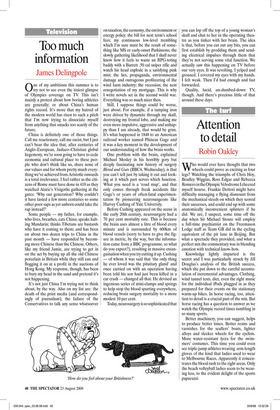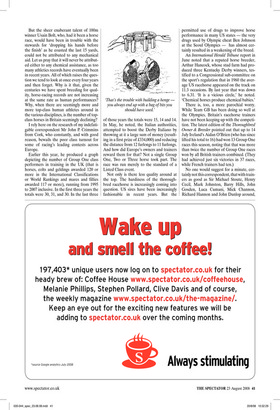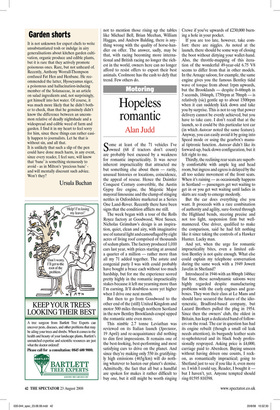Attention to detail
Robin Oakley
Who would ever have thought that two wheels could prove as exciting as four legs? Watching the triumphs of Chris Hoy, Bradley Wiggins, Ross Edgar and Rebecca Romero in the Olympic Velodrome I cheered myself hoarse. Frankie Dettori might have difficulty managing a flying dismount from the mechanical steeds on which they scored their successes, and could end up with some anatomically inconvenient splinters if he did. We are, I suspect, some time off the day when Sir Michael Stoute will employ a full-time psychiatrist on the Freemason Lodge staff as Team GB did in the cycling equivalent of the pit lane in Beijing. But what a spectacle they provided, and what a perfect mix the commentary was in blending emotion with technical know-how.
Knowledge lightly imparted is the secret and I was particularly struck by Jill Douglas’s analysis of the British success, which she put down to the careful accumulation of incremental advantages. Clothing, wind tunnel tests, diet, even the right music for the individual iPods plugged in as they prepared for their events on the stationary warm-up bikes. In horse racing, too, attention to detail is a crucial part of the mix. But horse racing has a question to answer as we watch the Olympic record times tumbling in so many sports.
Better machinery, you can suggest, helps to produce better times. Better resins and varnishes for the scullers’ boats, lighter alloys and sleeker wheels for the cyclists. More water-resistant lycra for the swimmers’ costumes. This time you could even see triple-jump athletes wearing arm-length gloves of the kind that ladies used to wear to Melbourne Races. Apparently it concentrates the blood rush to the right areas. Only the beach volleyball ladies seem to be wearing less, to the evident delight of the sports paparazzi. But the sheer exuberant talent of 100m winner Usain Bolt, who, had it been a horse race, would have been in trouble with the stewards for ‘dropping his hands before the finish’ as he coasted the last 15 yards, could not be attributed to any mechanical aid. Let us pray that it will never be attributed either to any chemical assistance, as too many athletics records have eventually been in recent years. All of which raises the question we tend to look at once every four years and then forget. Why is it that, given the centuries we have spent breeding for quality, horse-racing records are not increasing at the same rate as human performances? Why, when there are seemingly more and more top-class human athletes around in the various disciplines, is the number of topclass horses in Britain seemingly declining?
I rely here on the research of my indefatigable correspondent Mr John P. Crimmins from Cork, who constantly, and with good reason, bewails the poor class turnout for some of racing’s leading contests across Europe.
Earlier this year, he produced a graph depicting the number of Group One class performers in training in the UK (that is horses, colts and geldings awarded 120 or more in the International Classifications or World Rankings and mares and fillies awarded 117 or more), running from 1995 to 2007 inclusive. In the first three years the totals were 30, 31, and 30. In the last three of those years the totals were 15, 14 and 14. In May, he noted, the Italian authorities, attempted to boost the Derby Italiano by throwing at it a large sum of money (resulting in a first prize of £334,000) and reducing the distance from 12 furlongs to 11 furlongs. And how did Europe’s owners and trainers reward them for that? Not a single Group One, Two or Three horse took part. The race was run merely to the standard of a Listed Class event.
Not only is there less quality around at the top. The hardiness of the thoroughbred racehorse is increasingly coming into question. US sires have been increasingly fashionable in recent years. But the permitted use of drugs to improve horse performance in many US states — the very drugs used by Olympic cheat Ben Johnson at the Seoul Olympics — has almost certainly resulted in a weakening of the breed.
An International Herald Tribune report in June noted that a reputed horse breeder, Arthur Hancock, whose stud farm had produced three Kentucky Derby winners, testified to a Congressional sub-committee on the sport’s regulation that in 1960 the average US racehorse appeared on the track on 11.3 occasions. By last year that was down to 6.31. ‘It is a vicious circle,’ he noted. ‘Chemical horses produce chemical babies.’ There is, too, a more parochial worry. While Team GB has been doing so well at the Olympics, Britain’s racehorse trainers have not been keeping up with the competition. The latest edition of the Thoroughbred Owner & Breeder pointed out that up to 14 July Ireland’s Aidan O’Brien (who has since lifted his total to 16) had won 13 Group One races this season, noting that that was more than twice the number of Group One races won by all British trainers combined. (They had achieved just six victories in 37 races, while French trainers had ten.) No one would suggest for a minute, certainly not this correspondent, that with trainers as good as Sir Michael Stoute, Henry Cecil, Mark Johnston, Barry Hills, John Gosden, Luca Cumani, Mick Channon, Richard Hannon and John Dunlop around, not to mention those rising up the tables like Michael Bell, Brian Meehan, William Haggas, and Andrew Balding, there is anything wrong with the quality of horse-handler on offer. The answer, sadly, may be that, with racing becoming more international and British racing no longer the richest in the world, owners here can no longer afford to resist offers to export their best animals. Coolmore has the cash to defy that trend. Few others do.




























































 Previous page
Previous page